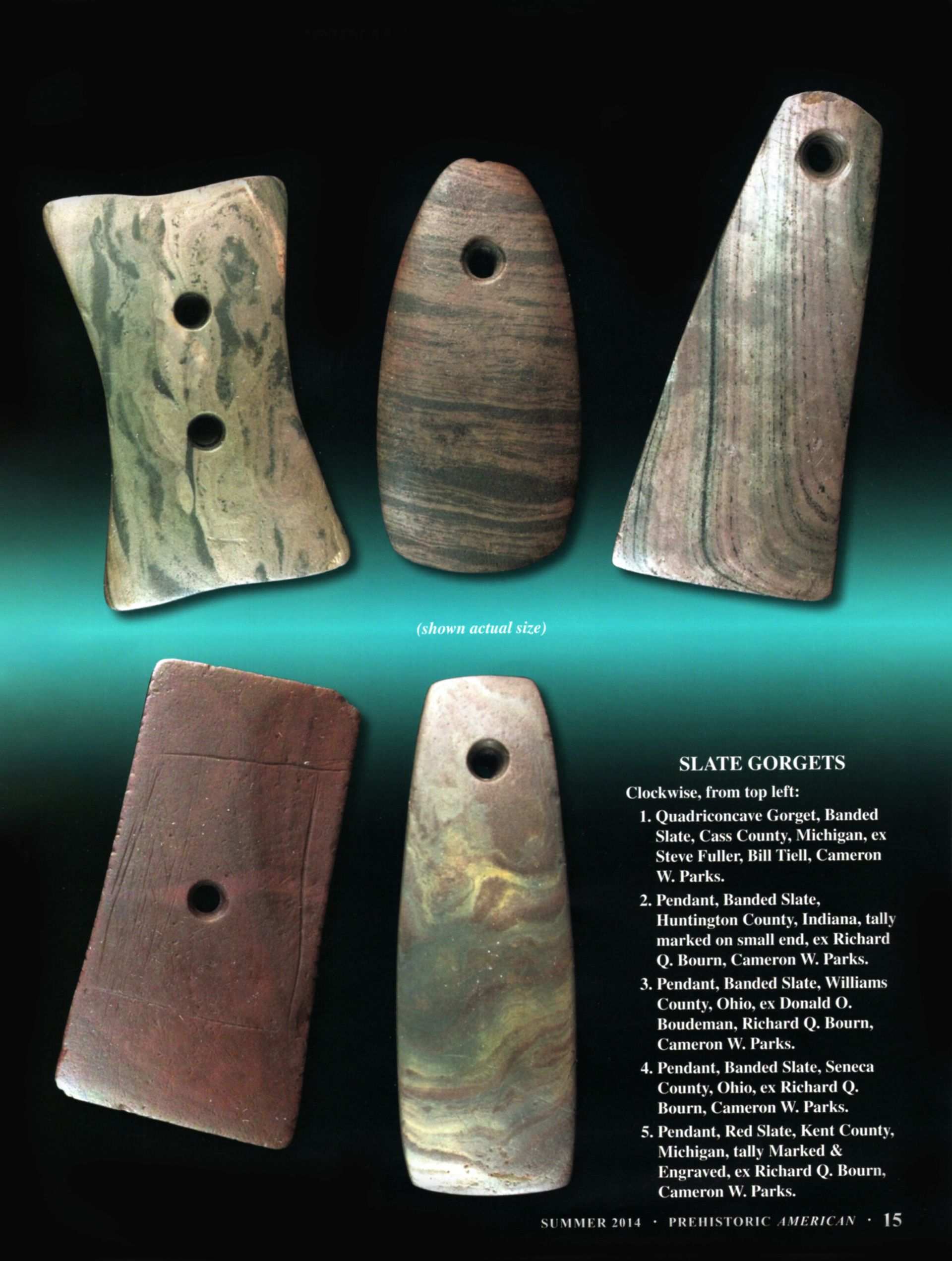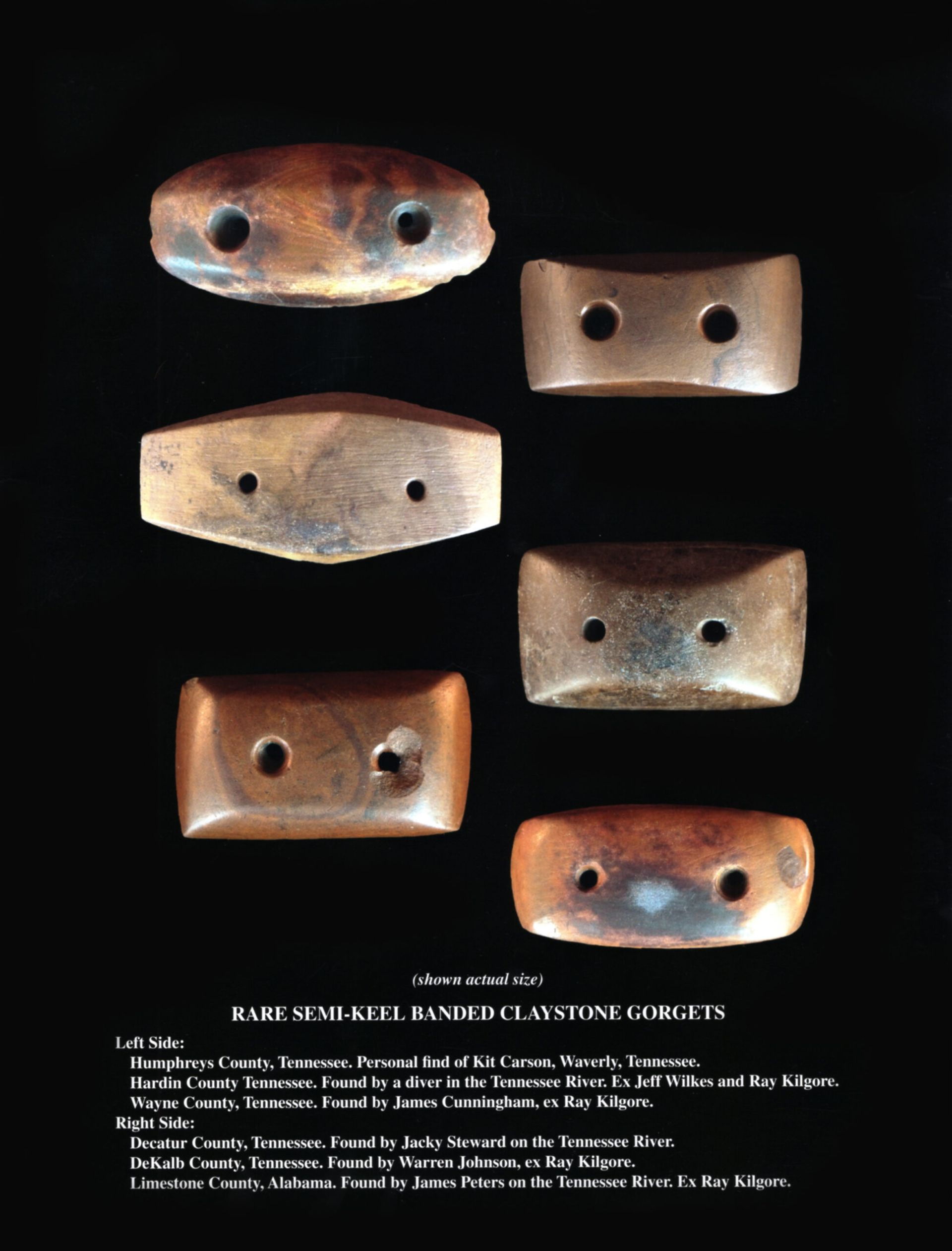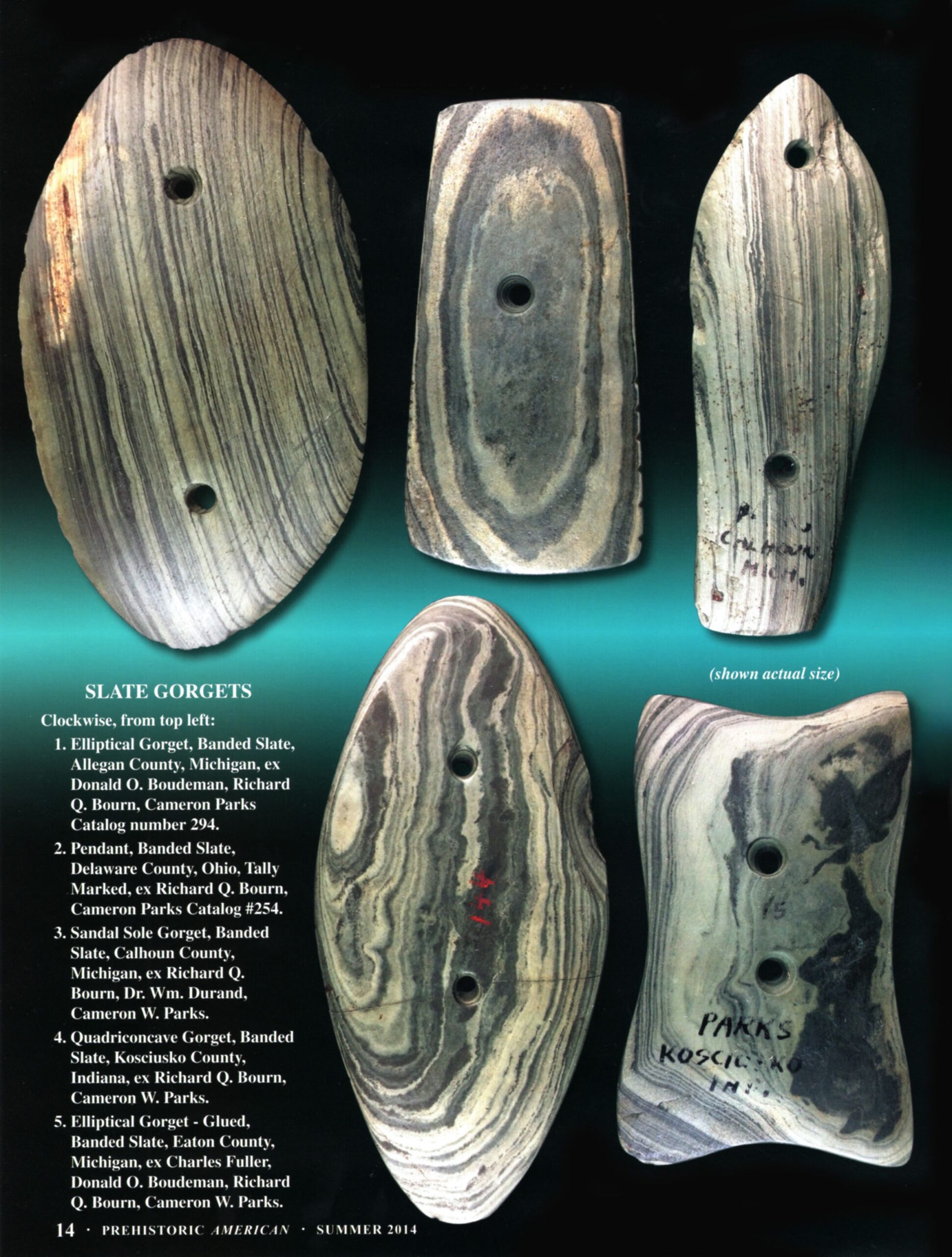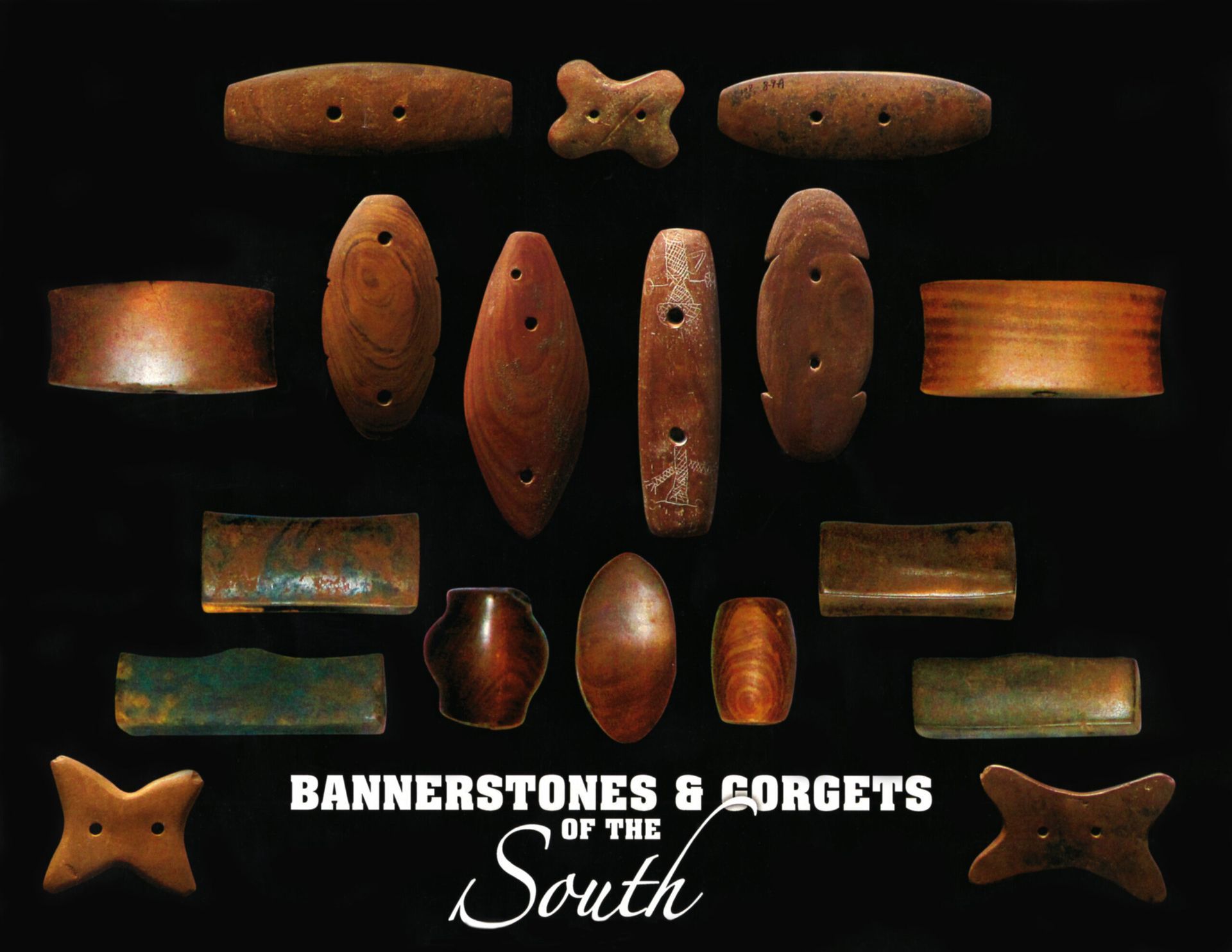Learn About Gorgets
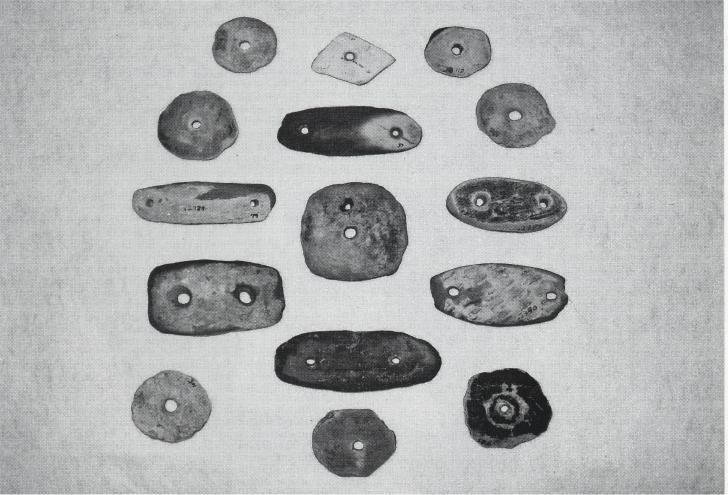
By John Baugh
•
September 15, 2025
by John Baugh, Tampa Florida Originally Published in the Central States Archaeological Journal , Vol.55, No.3, pg.131 Many of Florida’s early inhabitants lived along the St. Johns River in Volusia County. One of these ancient cultural groups resided on Tick Island during the transitional/St. John’s I period (500 BC — 800 AD), and produced unique pottery gorgets and pendants. I have enjoyed the privilege of collecting them over the last twenty-five years, and have always regarded their raw primal simplicity as their most attractive feature. The distinctive pottery gorgets and pendants of this area were manufactured of local clay from freshwater sources and fired for hardness under low temperature heat. This unique clay contained natural inclusions of freshwater sponges, which acted to strengthen the objects without additional tempering agents and also produced the associated soft chalky surface commonly referred to as St. John’s Paste. This type of pottery is believed to have evolved from the Late Archaic Orange Pottery, a plant fiber tempered ceramic material found on the earliest ceramic sites here in Florida. Examples of the Tick Island gorgets most commonly have two holes used for suspension, being most often rectangular, and occasionally ovoid or square in shape. Average width is approximately 3″, and about 1 1/2″ tall. Rare examples are punctated or incised, with most being undecorated. The pendants are predominantly round with a single central hole, averaging 2″in diameter, with infrequent examples being diamond shaped. Each one is a rare treasure of Florida’s past. I have found them to be illusive, and scarcely existent in public or private collections, and have resolved to compile and preserve the specimens that have been placed in my guardianship over the years. The Tick Island Mound and midden complex was destroyed in the 1960s for commercial purposes. It’s said that portions of the site could be scattered as far south as Palm Beach, the shell having been used to construct many of Florida’s road foundations. Little more than a vast pool of water remains today where a once thriving and vibrant early cultural complex once stood. All is gone except a small quantity of remaining items that include the pottery gorgets and pendants of Tick Island, Florida.”Used by Permission of the Author” To learn more about or to join the Central States Archaeological Society, click here: CSASI.org
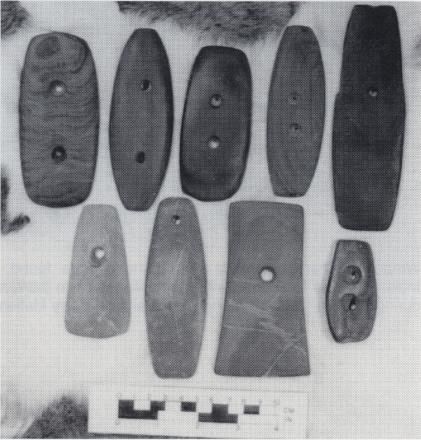
By James Tharpe
•
September 15, 2025
By James Tharpe, Plainfield, Indiana Gorgets at first glance take on a similar appearance in shape to that of the undrilled bar type bannerstone. This form of artifact can vary greatly in form, but yet be so similar that it is possible to pass from one of one type to another of absolutely different type by steps so gradual that the transition seems quite natural. In this attempt to describe a gorget no fixed line can be drawn separating them from pendants on one side and bannerstones on the other. Its derivative may be linked through or with the Late Archaic Glacial Kame Culture. What is known is that the gorget dates from the Late Archaic time and continued through the Mound Builder and Woodland Cultures. Therefore the gorget may have coexisted with some forms of the bannerstone. The name gorget is derived from the word “gorge” or throat, because many of these artifacts are believed to have been worn at the throat or upon the chest. However early explorers saw the Miami Indians wearing the gorget fastened to the hair. Today some women wear a similar object as a hair decoration. Today they are made of leather with a large hairpin positioned through two holes of the leather piece, while another similar object is made entirely of plastic. While banded slate was greatly used for gorget manufacturing, a variety of other materials were also used. Examples of these are soapstone, limestone, shell, and granite; however, granite was rarely used. Besides the flat pendant type of gorget, the long, thick, bar-shaped gorget includes the perforations of two or more drilled holes. Special notice has been taken in regards to the Adena and Hopewell gorgets for their overall contour and shapely design. Adena forms range from the expanded center, quadriconcave, bi-concave, rectangular and semi-keeled shapes. Hopewell ranges from rectangular, expanded center (a different form of the Adena), and boat-shaped. The drilling process with the Adena and Hopewell culture is from one side, that being the flat surface. All other forms of the gorget generally are drilled from both sides with a common meeting in the center of the artifact. The drill would be made from flint for its hardness and durability while perforating a given stone. During the drilling process a cone taper shape occurs, finally reaching a point where the stone is breached from one side or the other. Occasionally an unfinished gorget is found without the boring of the holes and those that have only one hole are considered to be pendants. Pendants were worn about the neck much in the same manner as gorgets. Observed on the edges of some pendants and gorgets are notched cut marks called tally marks. These marks are not regularly placed on the stone and are not thought of being just decorative. It is conjectural that this may have served as a record of events. The boat-shaped gorget of the Hopewell Culture has a flat surface and a elevated convex upper surface although some types of this group may only have a slight convex. The drilling is from the flat surface until the stone is breached through. Often a slight chamfering of the hole was done from the upper or convex side. These gorgets tapered from an expanded center to either pointed or squared tips.
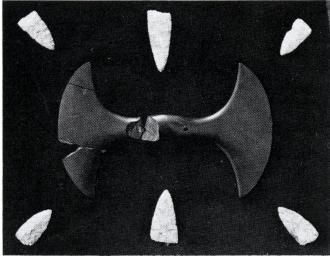
By Bill Koup
•
September 15, 2025
By Bill Koup, Albuquerque, New Mexico Personal adornment has always been an important pursuit of mankind. The wearing of specialized adornments for the purpose of appearing more attractive or to signify an individual’s rank, wealth or status has been documented with great regularity throughout the entire scope of mans’ history. Even the scarification and tattooing of skin has frequently signified great wealth or high status with particular societies. The use of various forms of jewelry and other decorative embellishments to the body or clothing has long been and probably always will be a popular and significant form of personal expression for nearly all humankind. The prehistoric peoples of North America were in no way different to other societies in this regard. Literally thousands of artifacts including pendants and gorgets have been recovered that have no apparent use other than to enhance the owner’s personal presence. Some of these artifacts are most certainly akin to jewelry. Many of these items were worn to please the owner and to perhaps impress others of their personal wealth or sexual attractiveness. Certainly, there were many other types of adornments other than pendants and gorgets made and worn for the express purpose of signifying status within their respective societies. Perhaps a good anology would be the various patches and insignias worn by military personnel to designate rank, service and prestige. Another anology would be pins, watches, money clips and other items that have been awarded to individuals for their distinguished service at their place of employment. Even designer clothing with specific logos may be considered late 20th century manifestations of the desire for people to adorn themselves in ways to exhibit wealth or status. So, are pendants and gorgets merely items of personal adornment worn to impress others or to signify status or wealth? Although no one at this time can be absolutely certain of the specific meaning of pendants and gorgets, chances are pretty good that is exactly what they are. Unlike many other artifact types whose specific purpose and use is highly speculative, pendants and gorgets appear to have been used as items of status, societal affiliation and certainly for personal adornment. Indeed, there is a significant body of documented archaeological evidence illustrating the fact that pendants and gorgets were worn as items to be proudly displayed on the body or clothing of the owner. Pendants and to a lesser degree gorgets, have been discovered in nearly all areas of North America and among nearly all prehistoric cultures. They have been located in controlled archaeological excavations and on the surface as isolated field finds. Although most areas of North America had at one time supported pendant and gorget producing people, the Midwest and South seem to be centers for the production of these interesting forms. Indeed, the Glacial Kame, Adena, Hopewell, Ft. Ancient and Mississippian cultures from Ontario,Canada, throughout the Great Lakes areas down the Ohio and Mississippi River valleys all produced various distinctive pendant and gorget forms. So distinctive and stylistically similar are many of these forms that it has become relatively easy to identify them as having been produced by a specific culture. It is even possible to identify some types of gorgets and pendants as being either early, middle or late in the scope of a particular society’s existence.
